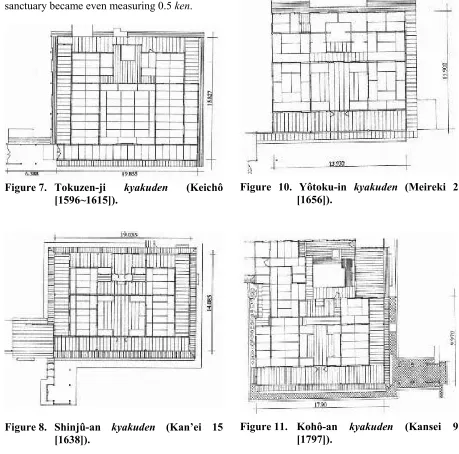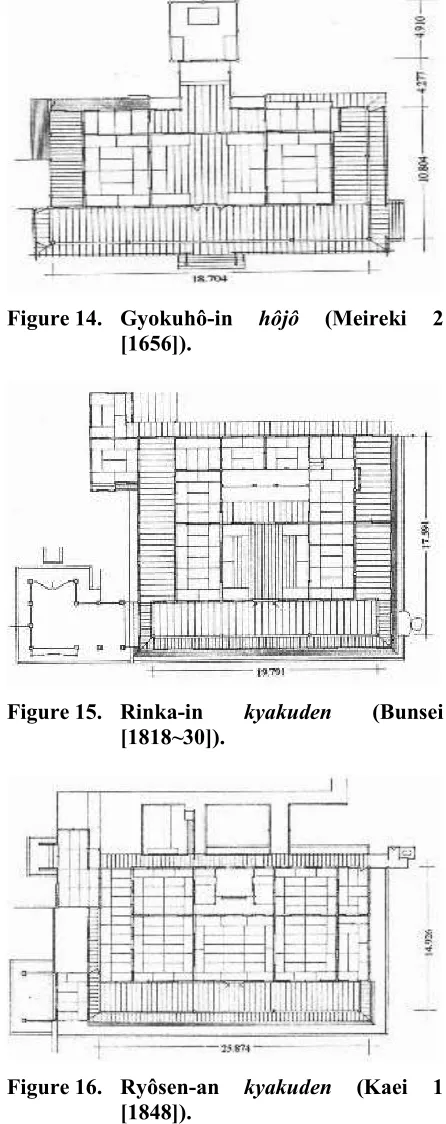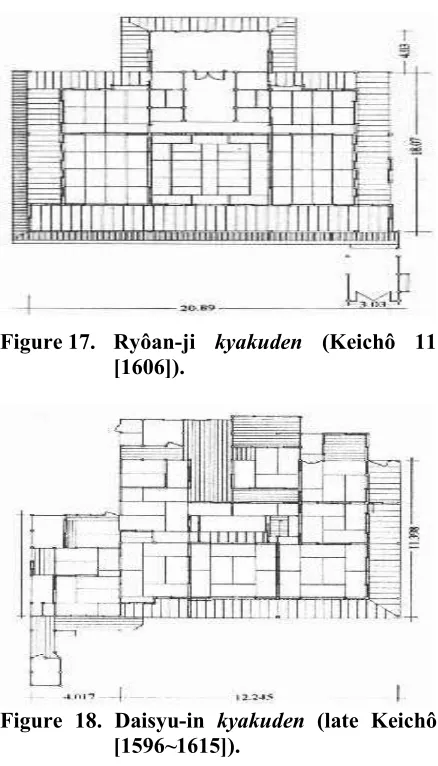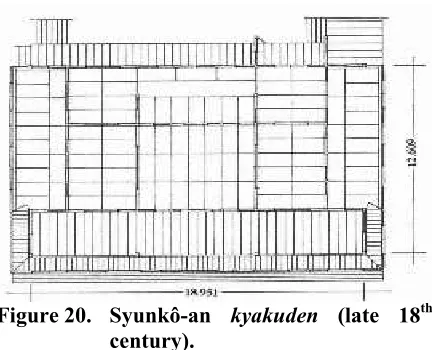THE TYPES OF PLANS AND INTERIOR DESIGN
AT MEMORIAL CLOISTERS OF DAITOKU-JI AND MYÔSHIN-JI
TEMPLES IN KYÔTO, IN THE EDÔ PERIOD [1596~1868]
-The Development and Changes of the Sanctuary-
Antariksa
Lecturer Department of Architecture Faculty of Engineering Brawijaya University e-mail: [email protected]
ABSTRACT
In the early Edô period the number of memorial cloisters (tacchû) increased, especially, at Daitoku-ji and Myôshin-ji temples. As a consequence, the hondô (kyakuden, hôjô) were further developed in all aspects of architectural style, interior design and plan.
This study will attempt to clarify the types of plans at memorial cloisters of both temples, by analyzing the arrangement and composition of the sanctuary, during the Edô period.
In that period, the requirement of the rooms was interlaced with the function, and even dependent upon everyday life and the activities of religious services.
Keywords: Edô period, memorial cloister, sanctuary.
INTRODUCTION
The percentage of newly established memorial cloisters was extremely high around Keichô [1596~1615] ~ Genna [1615~1624] ~ Kan'ei [1596~1644]. (Mitsugu, 1982) Most of the memorial cloisters developed mainly through the great monasteries, Daitoku-ji and Myôshin-ji, both of which are not members of the gozan
group. In the medieval ages, Rinzai sect temples in Kyôto, such as Nanzen-ji, Shôkoku-ji, Tenryû-ji, Kennin-Tenryû-ji, Tôfuku-ji and Manju-ji temples became the center of the gozan group. They were called ‘sorin’. While Daitoku-ji and Myôshin-ji temples belonged to the ‘rinka’ group of Rinzai sect temples (Norio, 1990; Kyotôfu Kyôiku Iinkai, 1983; and Mitsugu, 1979).
From then until Kansei [1801] was a phase characterized by reconstruction and regeneration of Rinzai Zen sect memorial cloisters, as many sophisticated building were shown from Bunsei 1 [1818] to Kaei 1 [1848]. As a consequence, most of the design of the hondô (kyakuden, hôjô)1
1
Generally, the hondô (kyakuden, hôjô) of memorial cloisters consists of six rooms. To the south of the buildings, there is hiroen (1 to 1.5 ken veranda). Behind the
hiroen, there are three rooms opening to the south. Behind them, on the north side of the building, there is another set of rooms. Among the three southern rooms, the central one is the main room of the hôndô (kyakuden, hôjô) and is called shittchû, or "middle chamber." It is used for performing religious services. Of the rooms found in either
were further developed during this period in architecture style, interior design and plan.
This study was based on materials collected in Kyôtofu no kinsei shaji kenchiku kinkyu chôsa hôkokusho (Surveyed reports of Edô period temples and shrines in Kyôto prefecture, 1983),
Jûyô bunkazai shûri kôji hôkokusho (Repair and reconstruction reports for important cultural properties, 1978), historical records and field research. From these references more than 33 memorial cloisters of late medieval and Edô period, belonging to Daitoku-ji and Myôshin-ji temples, were selected (see Table I and Table II). Secondly, in accordance with the selected cloisters, this study will classify the periods in which hondô (kyakuden, hôjô) were built. The selected memorial cloisters of Daitoku-ji temple, can be divided into groups of four periods as follows: the late medieval age, from Eisyô 10 [1513] to Tensyô 16 [1588]; the early Edô period from Keichô 1 [1596] to Meireki 2 [1656]; the
side of this central room, the one closer to the entrance is considered as the gekan or shitanoma (lower room) and is called rainoma. The remaining room, is considered the
jôkan or uenoma (upper room), and is called dannanoma
(donor's chamber). These three front rooms and the central room are collectively called the kyakuden (guest chamber). Of the three northern rooms, the central room is butsuma
(sanctuary) and minzô (sleeping chamber), whereas the eastern room is the shoin and the western room is the
mid-Edô period, around Kansei 9 [1797]; and the late Edô period, around Bunka 14 [1817]. At Myôshin-ji temple, they can also divided into groups of three periods as follows: the early Edô period, from Keichô 4 [1599] up to Meireki 2 [1656]; the mid-Edô period from Genroku 6 [1693] up to late 18th century; and the late Edô period from Bunsei [1818-30] up to Kaei 1 [1848].
The purpose of grouping by periods is to clarify the development and change of memorial cloisters over a short period of time. Thirdly, based on classifications of the periods, this study will attempt to clarify the types of plans and sanctuary of the hondô (kyakuden, hôjô) of both temples, including the arrangement and the composition of the sanctuary, during the Edô period.
Table 1. The selected memorial cloisters (tacchû) of late medieval age and Edô period at Daitoku-ji temple.
No name of
clisters
building length width date of construction floor of
front
ita (wooden boards floor).
ken (traditional unit of measure equivalent to 6 shaku, or approximately 1.82 meters)
Table 2. The selected memorial cloisters (tacchû) of Edô period at Myôshin-ji temple.
No name of clisters building length width date of construction floor of front altar
ita (wooden boards floor).
THE ARRANGEMENT AND COMPOSITION OF SANCTUARY
The sleeping chamber (minzô)2
The innermost sanctuaries of late medieval age memorial cloisters at Daitoku-ji are constructed with the sleeping chamber placed to the rear or right part of the butsudan (Buddhist altar). These kinds of sleeping chambers are seen at Daisen-in hondô (Eisyô 10 [1513]), Ryôgen-in
hondô (Eisyô 14 [1517]), Kôrin-in hondô
(Tenbun 1 [1532] ~ Eiroku 12 [1569]), Zuihô-in
hondô (Tenbun 21 [1522] ~ Kôji 3 [1557]), Jukô-in hondô (Tensyô 11 [1583]), and Ôbai-in hondô
(Tensyô 16 (1588))3. (Figure 1) In the early Edô period around Keichô [1596-1615] and after Kan'ei (1624-44), the sleeping chamber gradually disappeared. However, in the early Edô period, it appeared at Gyokurin-in kyakuden (Genna 7 (1621)) and was placed at the rear of the sanctuary4. (Figure 2) But since then, sleeping chamber were not constructed in the innermost sanctuary. Whereas at Myôshin-ji, sleeping chamber were only constructed during the early Edô period as seen at Yôgen-in kyakuden
(Keichô 4 [1599]) (Figure 3), Taizô-in kyakuden
(Keichô 7 [1602]) (Figure 4) and Kôbai-in
kyakuden (Keichô 9 [1604]) (Figure 5), then once again reappearing at Tenkyû-in kyakuden
(Kan'ei 12 [1635]). (Figure 6)
2
Minzô, as speaking in Japanese is nurigome, originally means bedroom. This is built in shoin building and used bedroom or trunk room. In this room, books and daily use clothes were stored. In the left side room, the former priest used to sit in meditation and have a slight sleep.
3
In the case of Ôbai-in hondô the western (left) sleeping chambers was constructed in Bunka 1 [1804]. In the early Edô period around Keichô [1596-1615] and after Kan’ei [1624-1644], sleeping chamber gradually disappeared.
4
In the case of Gyokurin-in kyakuden, the present condition of the sanctuary was set overall length cross width of the Buddhist altar, and sleeping chamber was placed at the rear, consisting of 3 tatami
mats and 4 tatami mats of floor space in the room. Later, the
shinzen (front of Buddhist altar) was reformed to placement of the carved statue of the cloisters founder, then both of the chambers at the rear side disappeared. It takes the place of small rooms at the rear side veranda.
Daisen-in hondô (Eisyô 10 [1513]).
Ryôgen-in hondô (Eisyô 14 [1517]).
Figure 1. These kind of sleeping chambers.
Figure 3. Yôgen-in kyakuden Keichô 4 [1599]).
Figure 4. Taizô-in kyakuden (Keichô 7 [1602]).
Figure 5. Kôbai-in kyakuden (Keichô 9 [1604]).
Figure 6. Tenkyû-in kyakuden (Kan’ei 12 [1635]).
Therefore, the sleeping chambers in the memorial cloisters of Myôshin-ji temple existed from the early Edô period, around Keichô 4 [1599] until around Kan'ei 12 [1635]. After the end of that period, from around Kan'ei 13 [1636] up to the late Edô period around Kaei 1 [1848], the sleeping chamber did not existed. The sleeping chamber of both temples disappeared in the same period, at Daitoku-ji in and at Myôshin-ji in around Kan'ei 13 [1636]. The basic composition of the rooms in the innermost sanctuary consists of shinzen (the front of the Buddhist altar), a butsudan (Buddhist altar), and a minzô (sleeping chamber). The disappearance of the sleeping chamber was caused the innermost sanctuary changed to replace the function of other rooms, for example to set the carved statue of the cloister founder, ihaidan (the altar to lay the ancestral tablets of parishioners) and construct monoire (storage room) or nando
(trunk room). The basic composition and arrangement of the rooms of medieval age hondô
is not different. But the sanctuary and sleeping chamber were changed (Mitsugu, 1992).
The frontage and depth of sanctuary
In the late medieval age, the frontage of sanctuary of memorial cloisters at Daitoku-ji temple have on the average a length of 3.5 ken5
and depth of 1.5 to 2 ken (see Table I). During that period, on the average, the depth is shallow as seen at Daisen-in hondô and Zuihô-in hondô, each frontage are 1.5 ken. In the early Edô period several memorial cloisters having the same depth
5
(2 ken) as seen at Tokuzen-ji kyakuden (Keichô [1596~1615]) also have a frontage of 4 ken
(Figure 7), Gyokurin-in kyakuden and Shinjû-an
kyakuden (Kan’ei 15 [1638]) (Figure 8). In that period, two memorial cloisters of Syûon-an
kyakuden (Jôô 3 [1654]) (Figure 9) and Yôtoku-in kayakuden (Meireki 2 [1656]) (Figure 10) have a frontage of 3 to 3.5 ken and depth of 1.5
ken. These were not different from the mid-Edô period, around Kansei 9 (1797) up to late Edô period, around Bunka 14 [1817]. The memorial cloisters which have an equal frontage of 3 ken
and depth of 1.5 ken, as at Kohô an hondô
(Kansei 9 [1797]) (Figure 11) and Sangen-in
kyakuden (Bunka 14 [1817]). (Figure 12) In the early Edôperiod, around Meireki 2 [1656] up to late Edô period, around Bunka 14 [1817] memorial cloisters at Daitoku-ji temple, the length of both frontage and depth of the sanctuary became even measuring 0.5 ken.
Figure 7. Tokuzen-ji kyakuden (Keichô [1596~1615]).
Figure 8. Shinjû-an kyakuden (Kan’ei 15 [1638]).
Figure 9. Syûon-an kyakuden (Jôô 3 [1654]).
Figure 10. Yôtoku-in kyakuden (Meireki 2 [1656]).
Figure 12. Sangen-in kyakuden (Bunka 14 [1817]).
The memorial cloisters of Myôshin-ji temple in the Edô period, on the average, have a length of frontage of 2 to 3.5 ken and depth of 1 to 2.5 ken (see Table II). Several memorial cloisters have a depth of 2 ken, for example Yôgen-in kayakuden, Taizô-in kayakuden and Kôbai-in kyakuden. In that period, several memorial cloisters have a frontage of 2 to 3.5 ken
and depth 1 to 2.5 ken. For example, in the case of Keisyun-in kyakuden (Kan’ei 8 [1631]), the column spacing of the frontage is quite short in length, at 2 ken, and depth, at 1 ken (Figure 13). In that period, one of the memorial cloisters has a frontage of 3.5 ken and depth of 1 to 2 ken, such was the case of Gyokuhô-in hôjô (Meireki 2 [1656]), it has a depth shorter by 1 ken (Figure 14). Several memorial cloisters of the late Edô period, around the late 18th century up to around Kaei 1 [1848] have a frontage of 3.5 to 4 ken and depth of 2 to 2.5 ken. As seen at Rinka-in
kyakuden (Bunsei [1818-1830]) (Figure 15) and at Ryôsen-an kyakuden (Kaei 1 [1848]) (Figure 16). Both have a frontage of 4 ken and depth of 2.5 ken.
Figure 13. Keisyun-in kyakuden Kan’ei 8 [1631]).
Figure 14. Gyokuhô-in hôjô (Meireki 2 [1656]).
Figure 15. Rinka-in kyakuden (Bunsei
[1818~30]).
Figure 16. Ryôsen-an kyakuden (Kaei 1 [1848]).
cloisters of Daitoku-ji temple have more rigid on columns spacing than the memorial cloisters of Myôshin-ji temple, therefore providing a more relaxed atmosphere. Another type of hondô
which was developed can be seen at memorial cloisters of Daitoku-ji temple, in which the innermost sanctuary is arranged to deify the portrait of the cloister founder, and the front of the Buddhist altar is prepared to replace the function of shôdô (mortuary room). At Daisen-in
hondô the shôdô is not found, and therefore as a replacement at the front side of the sanctuary
shinzen are provided (Kin’ya, 1988). Generally, in the early Edô period at Daitoku-ji temple the spaces of the front of the Buddhist altar and mortuary room were simultaneously expanded. Daitoku-ji temple is the oldest example, it seems the renovations were conducted around Kan’ei 19 [1642] (Kin’ya, 1988).
The front and rear of sanctuary
The front side of the sanctuary of early Edô period memorial cloisters of Myôshin-ji temple was extended by 0.5 to 0.75 ken and the rear side was expanded out by 0.75 to 1.25 ken. As seen at Yôgen-in kyakuden, Taizô-in kyakuden, Kôbai-in
kyakuden, Ryôan-ji kyakuden (Keichô 11 [1606]) (Figure 17), Daisyu-in kyakuden (late Keichô [1596-1615]) (Figure 18) and Syôtaku-in
kyakuden (early 17th century). (Fig. 19) In the case of Yôgen-in kyakuden, originally, 0.5 ken, and the rear side consisted of Buddhist altar and sleeping chamber extended the front of the sanctuary. In Meireki 1 [1655] the kyôdô was reformed for placement the carved statue of the cloister founder. The extension of the rear side of the building was conducted on the reform between Meireki 1 [1655] up to Tenpô 9 [1838] (Kyotôfu Kyôiku Iinkai, 1994). In the case of Ryôan-ji kyakuden, originally, the rear side of the sanctuary was expanded by 2 ken constructed a kaisandô (the room to lay the carved statue of the cloister founder), and the rear veranda 1 ken
was taken inside. The present condition, the
kaisandô was moved out and the rear of the sanctuary surrounded by 1 ken veranda.
Further, in the early Edô 0.75 to 1.5 ken extended period at several memorial cloisters of Daitoku-ji temple, at the front side out and the rear side was expanded out by 0.5 ken. In the late Edô period, several memorial cloisters have the front side extended out by 0.5 to 1 ken and the rear side expanded out by 1 ken. During this period one of memorial cloisters had its rear expanded, as seen at Gyokurin-in hôjô. In the
mid-Edô period, around Genroku 6 [1693] up to late Edô period, around the late 18th century several memorial cloisters had the front side extended out by 0.5 to 1.5 ken. This is evident at Syunkô-in kyakuden (late 18th century) (Figure 20), Rinka-in kyakuden and Ryôsen-an
kyakuden.
Figure 17. Ryôan-ji kyakuden (Keichô 11 [1606]).
Figure 18. Daisyu-in kyakuden (late Keichô [1596~1615]).
Figure 20. Syunkô-an kyakuden (late 18th century).
Several memorial cloisters of the late medieval age at Daitoku-ji temple had their front sides extended by 0.5 to 1 ken and the rear side expanded out by 0.25 ken. Then, in early Edô period, around Keichô [1595-1615] up to Meireki 2 [1656] several memorial cloisters had the front side extended by 0.5 to 1 ken, and the rear side were expanded out by 0.25 to 1 ken. In that period, 0.5 to 1 ken also extended the fronts and rear side was expanded by 0.5 ken. At one of the memorial cloisters, a separate building at the rear side of the sanctuary was constructed, as at Syûon-an hôjô. In the early Edô period, several memorial cloisters were extended by 0.5 ken and their rear sides were expanded out by 0.5 ken. It is significant that, if compared to memorial cloisters of Myôshin-ji temple, those types were seen during the early Edô period, around Keichô [1596-1615]. The extension of 0.5 to 1.5 ken at the front side of the sanctuary was intended to placement of the carved statue of the cloister founder. Thus, the depth at the rear side of the Buddhist altar became narrow and short, and as a consequence the rear side was expanded around 0.25 to 1.5 ken, or a new building for placement of the carved statue of the cloister founder was constructed. Those inclination for the expansion of the sanctuary are seen in the early Edô period. In that period, the requirements of the rooms were interlaced with the function, dependent upon the activities of religious services.
CONCLUSION
The sleeping chamber at the memorial cloisters of Myôshin-ji and Daitoku-ji temples disappearance in the same period. The disappearance of the sleeping chamber was caused the inner chambers also changed to
replace the function of other rooms, for example the setting altar and the creation of store room or trunk room.
The length of the frontage increased to receive the larger number of worshipers attending the religious services, and therefore, the middle chamber as well became capacious. The frontage and depth of the sanctuary at memorial cloisters of Daitoku-ji temple seems to have a more rigid spacing than those do at Myôshin-ji temple, which are given an impression more independence.
The extension was necessary to set the Buddhist altar to create space for laying the carved statue of the cloister founder. Thus, the Buddhist altar become narrow and short, and as a consequence the rear side of the sanctuary of several memorial cloisters expanded about 0.25 to 1.5 ken, or a separate building was constructed. In that period, the requirement of the rooms was interlaced with the function, and even dependent upon everyday life and the activities of religious services.
ACKNOWLEDGEMENT
The author would like to thank his advisor, Professor Hyuga Susumu from the Laboratory of Japanese History of Architecture, at the Department of Architecture Faculty of Engineering and Design, Kyôto Institute of Technology, Kyôto, for his valuable advice and support. Special thanks to Professor Nagai Norio from the Department of Architecture, Faculty of Engineering, Kansai University, Osaka, and to Dr. Sugino Noboru from the Department of Architecture, Faculty of Engineering, Aichi Institute of Technology, Nagoya, for their comments and research support.
DAFTAR PUSTAKA
Antariksa and Susumu, Hyuga, Study of the
hondô (kyakuden, hôjô) of Rinzai Zen sect Buddhist Temples in Kyôto, in the Early Modern Age –Typical Reconstruction Plans- Memoirs of the Faculty of Engineering and Design, Kyôto Institute of Technology, 43 (march), pp.121-140, 1995.
Kyôto, in the Mid-Modern Age –Typical Reconstruction Plans-, Journal of Architecture Planning and Environmental Engineering (Transactions of AIJ), No. 484, June, pp.239-249, 1996.
Antariksa, Study of the hondô (kyakuden, hôjô) of Rinzai Zen sect Buddhist Temples in Kyôto, in the Late Modern Age –Typical Reconstruction Plans-, Journal of Architecture Planning and Environmental Engineering (Transactions of AIJ), No. 485, July, pp.237-248, 1996.
Hideya, Yokoyama, Zen’in no Kenchiku
(Architecture of Zen temples), Shokokusha, Tokyo, 1967.
Hirotaro, Ota, Kyô no Zendera (Zen temples in Kyotô), Tanko Shinsa, Kyotô, 1961.
Kyôtofu Kyôiku Iinkai, Jûyô Bunkazai Ôbai-in hondô shûri kôji hôkokushô (Repair and reconstruction reports for important cultural properties of tha main hall of Ôbai-in temple), Kyôtofu Kyôikucho Shidô Bunkazai Hôgoka, 1978.
Kyôtofu Kyôiku Iinkai, Kyôtofu no kinsei shaji kenchiku kinkyû chôsa hôkokusho (Survey reports on Edô period temples and shrines in Kyôto prefecture), Kyôtofu Kyôiku Iinkai Bunkazai Hôgoka, 1983
Mitsugu, Kawakami, Nihon Koji Bijutsu Zenshû: Myôshin-ji (Complete collection of Japanese ancient art: Myôshin-ji temple), vol. 24, Shueisha, 1982.
Mitsugu, Kawakami, Zen’in no Kenchiku
(Architecture of Zen temples), Kawara Shoten, 1968.
Nara Kokuritsu Bunkazai Kenkyûsho, Kinsei shaji kenchiku kenkyû shûkai kiroku
(Records of research meeting on Edô period temples and shrines), vol. 1, Nara Kokuritsu Bunkazai Kenkyûsho, 1988.
Ryûji, Miyamoto, Nihon Meikenchiku Shashin Senshû: Daitoku-ji (Complete photograph of Japanese famous architecture: Daitoku-ji temple), Vol. 12, Shinchosha, 1992.
Susumu, Miyama, 1988, Zusetsu Nihon no Bukkyô (Complete illustration of Japanese Buddhism: Buddhism in Kamakura period), vol. 4, Shinchosha, 1988.
Toshinori, Nakamura, Early History of the Teahouse Part III, Chanoyu Quarterly
(Tea and The Arts of Japan, No. 71), P. 31, 1992.
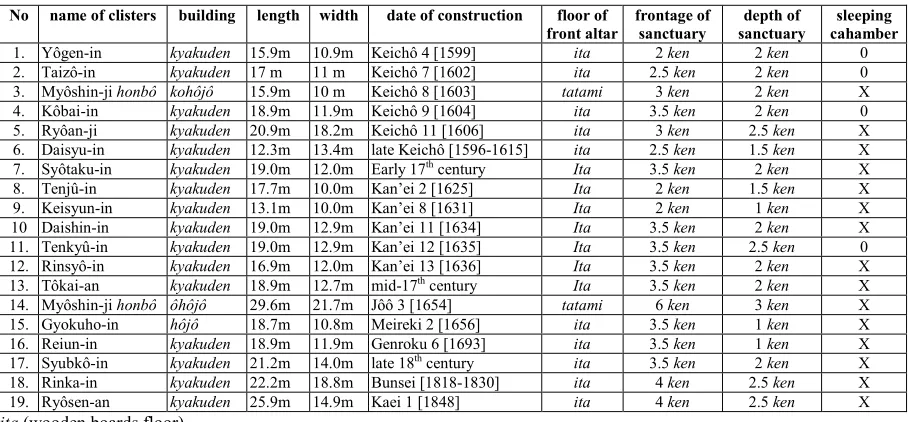
![Figure 2. Gyokurin-in kyakuden (Genna 7 [1621] ).](https://thumb-ap.123doks.com/thumbv2/123dok/3652565.1465955/3.595.293.511.526.715/figure-gyokurin-in-kyakuden-genna.webp)
![Figure 3. Yôgen-in kyakuden Keichô 4 [1599]).](https://thumb-ap.123doks.com/thumbv2/123dok/3652565.1465955/4.595.86.304.518.701/figure-yogen-in-kyakuden-keicho.webp)
